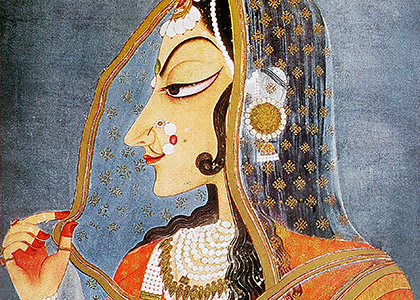Rajasthani Folk Arts - the Essence of Rajasthani Culture
India is a land filled with customs, traditions, arts, and literature. Various states of the country have its own stories engraved in the form of paintings. The state that has attracted numerous tourists is Rajasthan. Known for its mesmerizing forts that were built during the 14th centuries, this land has witnessed many historic battles. But what makes this state unique is Rajasthani folk arts and culture. The mesmerizing architecture of palaces and forts is a symbol of the skills of its artists. Various types of art forms are practiced in the state. Below is the list of folk art forms that reflect the jewels of the state.1. Thapa
This is a basic form of handmade painting that represents various Indian gods, goddesses, and religious ceremonies. To draw this beautiful art, artist use kumkum, sindoor, ghee, Heena, and cow dung. Women mainly draw this colorful art, and Kumkum is the main ingredient. Other primary colors like red, yellow, green, blue, black, and yellow are used to make it more attractive.2. Mandana
Mandan means decoration or ornamentation, and this creative art is all about decoration. It is first plastered with a mixture of cow dung and clay, which are drawn on the walls and floor of the house. This form of art is popular in Madhya Pradesh as well. Mandana are drowned on special occasions of religious festivals, fasts, auspicious ceremony or marriages.3. Gond Painting
Gond painting is a tribal art of pictures that is practiced by the tribal community. Apart from Rajasthan, other Indian states like Madhya Pradesh, Andhra Pradesh, Maharashtra, Chhattisgarh, and Orissa also practice this form of art. These paintings are used to decorate houses on special occasions and generally found on the walls of the homes and windows. Red, yellow, blue, black, and white are the primary colors in this painting. The decorative images taken from the oral natives of the Gond, like cockfight, scenes connected with forest and nature, agriculture, marriage, and other rituals, are drawn and painted in Gond painting.
See More: Top 7 Rajasthan Handicrafts
4. Rajput paintings

Rajput painting
|
5. Gudna Motif
Gudna Motif is a kind of tattoos that is drawn in the body with the help of a needle. This art is used many ingredients to add colors, and it is one of the most popular folk arts of Rajasthan. Artist use Kumkum, juice of harsingar flowers, milk of aak, and leaves of bilva plant to make Gunda Motif. This unique art includes images of gods and goddesses, swastika, sun, moon, flowers, birds, and animals. These designs have rituals and symbolic meanings.6. Shekhawati
These paintings are drawn directly on the walls of only floral and abstract compositions. This form of art was boomed after the decline of Mughal rule during the 19th century. The artists were heavily dependent on traditional Indian subjects like some of the scenes of mythology, Lord Krishna, local legends, plants, animals, daily lives of people and towns.
See More: 10 Popular Rajasthan Markets


